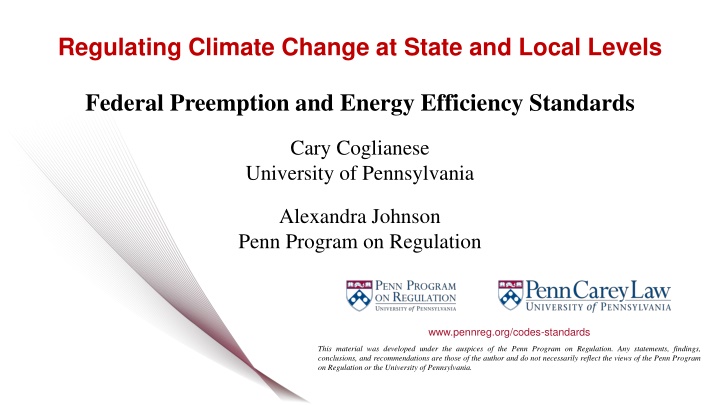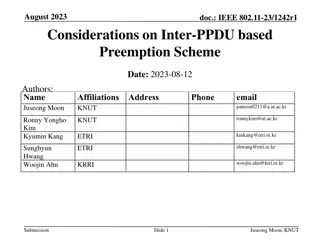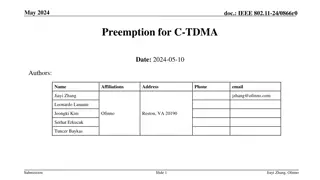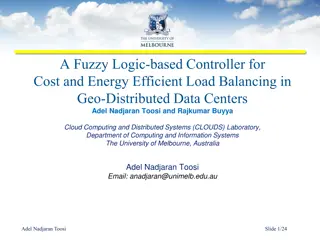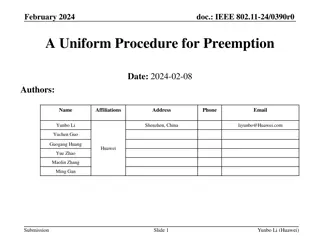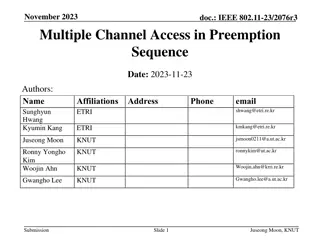Federal Preemption in Energy Policy: Balancing State and Federal Laws
Federal preemption plays a critical role in energy efficiency standards, impacting how state and federal laws interact. This article explores the types of preemption and its application in energy policy, including the development of binding standards and voluntary codes.
Uploaded on Feb 28, 2025 | 1 Views
Download Presentation

Please find below an Image/Link to download the presentation.
The content on the website is provided AS IS for your information and personal use only. It may not be sold, licensed, or shared on other websites without obtaining consent from the author.If you encounter any issues during the download, it is possible that the publisher has removed the file from their server.
You are allowed to download the files provided on this website for personal or commercial use, subject to the condition that they are used lawfully. All files are the property of their respective owners.
The content on the website is provided AS IS for your information and personal use only. It may not be sold, licensed, or shared on other websites without obtaining consent from the author.
E N D
Presentation Transcript
Regulating Climate Change at State and Local Levels Federal Preemption and Energy Efficiency Standards Cary Coglianese University of Pennsylvania Alexandra Johnson Penn Program on Regulation www.pennreg.org/codes-standards This material was developed under the auspices of the Penn Program on Regulation. Any statements, findings, conclusions, and recommendations are those of the author and do not necessarily reflect the views of the Penn Program on Regulation or the University of Pennsylvania.
What is Federal Preemption? What is Federal Preemption? The Supremacy Clause (Art. 6, cl. 2) provides that when state and federal laws conflict, federal law takes precedence Main types of preemption: Express Express language in a federal law specifies that it supersedes conflicting state law Implied Conflict: Arises when state law directly conflicts with federal law or would undermine the intended purpose of a federal law Field: Arises when federal law occupies a field of regulation so exhaustively that there remains no room for state law
How Does Federal Preemption Apply to Energy How Does Federal Preemption Apply to Energy Efficiency? Efficiency? Energy Policy and Conservation Act (EPCA) of 1975 Required federal Energy Department to develop binding standards to decrease energy consumption from appliances National Energy Conservation and Policy Act (NECPA) of 1978 Section 6297 of the US Code contains general rule that Energy Department standards supersede state standards Law passed in response to lack of action by the Carter Administration However, Reagan Administration eventually adopted a no-standards standard NRDC v. Harrington (1985) in D.C. Circuit Court Struck down the no-standards standard; ruled that statute required substantive standards National Appliance Energy Conservation Act (NAECA) of 1987 Established initial federal standards for residential and commercial appliances Energy Policy Act (EPACT) of 1992 Established federal energy efficiency standards for residential appliances
Voluntary Codes & Standards Voluntary Codes & Standards Developed by nongovernmental entities Developer organizations Trade associations Buyers may contractually require conformity with standards by their suppliers E.g., Underwriter Laboratories seal on electrical appliances Examples of standard-setting organizations ASTM International: a private organization which has published over 12,000 voluntary standards International Code Council (ICC): a nonprofit organization which develops model building codes National Fire Protection Association (NFPA): a nonprofit organization which develops standards related to addressing fire, electrical, and related risks American Society for Heating, Refrigeration and Air Conditioning (ASHRAE): a professional association which creates standards for heating, refrigerating, air conditioning, and ventilation systems and equipment
Incorporation by Reference (IBR) Incorporation by Reference (IBR) Definition: Governmental adoption of a private, voluntary code or standard merely by referring to the name or number of that code or standard in a regulation or legislation Once incorporated, voluntary codes and standards become mandatory, binding law The federal regulatory code contains over 24,000 provisions that contain references to voluntary codes and standards that have been incorporated Incorporation by reference is also prevalent at the state level: Example: California Department of Industrial Relations makes the ASTM International Standards on Amusement Rides part of its public law Example: The Oklahoma Board of Health has incorporated by reference portions of the International Code Council s International Building Code Model codes: Some standard-setting organizations develop model codes that are intended to become part of the law Legislators and regulators can and do adapt provisions in voluntary codes and standards to meet local conditions or preferences
Performance vs. Prescriptive Standards Performance vs. Prescriptive Standards Prescriptive: specifies action or technology that must be used Performance: establishes a goalpost Sets target level of energy use or energy consumption that cannot be exceeded Agnostic towards the method by which compliance is achieved
AlbuquerqueGreen: AlbuquerqueGreen: The City s Code The City s Code Mayor Ch vez s Green Ribbon Task Force sought to reduce carbon dioxide emissions by developing a green building code for adoption by the Albuquerque City Council The city amended its building code in 2008 to include requirements for energy efficiency, water use, and HVAC The new code provisions incorporated by reference ASHRAE Standard 90.1- 2004 and parts of the International Code Council s (ICC) energy code These incorporated provisions from nongovernmental codes and standards were stricter than federal standards
AlbuquerqueGreen: AlbuquerqueGreen: The Lawsuit The Lawsuit The Air Conditioning, Heating, and Refrigeration Institute (AHRI) and other businesses sue the city, arguing that its new provisions had been preempted by federal energy efficiency standards. Requested an injunction to halt implementation of the code Argued that city s more stringent standards would increase equipment costs The city responded by acknowledging that the incorporated code provisions from ASHRAE and ICC did call for equipment that exceeded federal standards. But the city argued that the code offered performance pathways as an alternative to comply which did not require equipment that exceeded federal standards.
AlbuquerqueGreen: AlbuquerqueGreen: The Relevant Law The Relevant Law Section 6297 of the National Energy Conservation and Policy Act (NECPA) provides that no State regulation concerning the energy efficiency, energy use, or water use of such covered product shall be effective with respect to such product. Section 6297 also contains a list of seven criteria which, if met, qualifies a state code from an exception to the statute s general rule on preemption. One key criterion holds that the state code must not require that [an appliance or piece of equipment covered by a federal standard] have an energy efficiency exceeding the applicable [federal] energy conservation standard. 6297(f)(3)(B) NECPA acknowledges the role for state building codes and even authorizes the federal government to provide grants to states to improve and implement State residential and commercial building energy efficiency codes.
AlbuquerqueGreen: AlbuquerqueGreen: The TheCourt s Rulings Court s Rulings In 2008, the federal district court in New Mexico ruled in favor of the business groups, issuing a preliminary injunction against enforcement of the city s building code. The court construed Section 6297 s preemption rule broadly, focusing on its preemption of state and local standards concerning energy efficiency. The fact that the code offered other options for complying instead of just the prescriptive ASHRAE and ICC requirements did not erase the fact that the code included some (even if optional) requirements calling for equipment that exceeded federal standards. Even though they do not explicitly require[e] a homeowner to install products that exceed federal energy standards, do require a homeowner to incur additional expense if the homeowner chooses to install products that meet, but do not exceed, federal energy standards. The need to incur additional expenses if federally-compliant products are used strongly suggests that the Code concerns the energy efficiency of covered products.
AlbuquerqueGreen: AlbuquerqueGreen: The TheCourt s Rulings Court s Rulings In 2010, the same court granted summary judgment striking down the prescriptive requirements in the code. Again, the judge construed preemption broadly: [t]he plain language of the preemption statute makes clear that Congress intended the preemption to be broad in scope. The judge looked at each option in the code separately and ruled that the prescriptive ASHRAE and ICC requirements were preempted. It did not matter that builders had other options that did not conflict with federal standards: The City does not point to anywhere where the Supreme Court stated that a local law is not preempted when it presents regulated parties with viable, non-preempted options. The judge reserved for trial whether the other options were preempted.
Washington 2030: Washington 2030: The State s Code The State s Code In 2009, Washington state adopted legislation calling for the state building code to achieve a 70% reduction in building energy use by 2031. The Washington State Building Code Council followed up with a revised building code that would achieve a 15% reduction starting in 2010 (against the baseline of the 2006 code). Builders had three main options under the code, one of which was total flexibility provided the 15% reduction was achieved (and verified using computer simulation software). (This provision was never challenged in court.) But two other options required selecting options from a list contained in a new Chapter 9 of the code, and some of these options involved equipment that exceeded federal standards. (Chapter 9 was what would be challenged in court.)
Washington 2030: Washington 2030: The Lawsuit The Lawsuit National building associations and local builders challenged the 2009 code in court They argued that the code did not meet all seven criteria needed to qualify for an exception to the general preemption rule found in Section 6297 of the U.S. Code. Specifically, they argued that the state did not meet the criterion for not requiring equipment that exceeded federal standards. Section 6297(f)(3)(B) stated that the state code must not require that [an appliance or piece of equipment covered by a federal standard] have an energy efficiency exceeding the applicable [federal] energy conservation standard. Since several of the options in the Chapter 9 list called for equipment in excess of federal standards, and since the other options that did not demand such equipment were more costly, the builders argued that the Chapter 9 effectively required equipment in conflict with federal standards.
Washington 2030: Washington 2030: The Trial Court s Ruling The Trial Court s Ruling The district court ruled that Chapter 9 not only never expressly required the use of equipment that exceeded federal standards, but it did not effectively or functionally require this use either. Moreover, even if it did functionally or effectively require such use, the industry s argument failed because [t]he text of the exemption provision [in Section 6297] does not include the terms functionally or effectively require.
Washington 2030: Washington 2030: The Appeals Court s Ruling The Appeals Court s Ruling The industry challengers appealed the trial court s decision. The appeals court took the language in Section 6297(f)(3)(B) literally and concluded that the state did not require the use of equipment that exceeded federal standards. Builders can choose. The Washington Building Code itself does not command, demand, or insist that builders select higher efficiency options. The mere fact that other options were more costly did not matter: Congress was concerned with the content of a regulation that was within state or local control. The market costs of products fluctuate outside the control of those who promulgate the codes. Congress cannot preempt market costs. The fact that certain options may end up being less costly to builders than others does not mean the state is, expressly or effectively, requiring those options. The only way a state could indirectly or effectively require use of a product that exceeded federal standards would be if the code itself imposed a penalty for not using higher efficiency products, which the Washington building code did not do. The appeals court upheld the trial court s decision upholding the state s building code.
Discussion: Federal Preemption Discussion: Federal Preemption What, if anything, might explain the different court outcomes in Albuquerque and Washington State? Do you think that high costs associated with an alternative compliance option in a regulatory code imposes a penalty on firms that choose that alternative? Does it then mean the code effectively requires regulated entities to take the other, less-costly option? Which legal outcome the one in Albuquerque or Washington State led to better outcomes for society? Should these outcomes affect decisions that judges make? What value for society does federal supremacy hold? Do private businesses benefit more from federal preemption by avoiding a patchwork of regulations at various levels of government? Or does the public benefit more from the creation of a consistent, minimum regulatory standard across all states including ones that might otherwise have weak regulations?
Discussion: Climate, Energy, and Subsidiarity Discussion: Climate, Energy, and Subsidiarity Are energy efficiency standards for buildings better set by the national government or by state and local governments? What are the advantages and disadvantages of regulating to address climate change at different levels of government the city, regional, federal, or international level? What role ought international voluntary codes and standards play in promoting energy conservation and addressing climate change?
